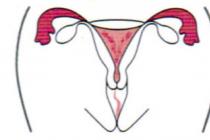While waiting for the baby, the expectant mother does not always feel well - sometimes she experiences a number of unpleasant sensations. For example, if you ask, many women will remember how badly their tailbone hurt during pregnancy. Acute or dull pain in the coccyx region torments almost all women in the early and late stages of a delicate position. Read about the causes of such discomfort and how to treat it in the article.
So, pain in the coccyx during pregnancy, as a rule, attacked every expectant mother at least once. The nature of such discomfort is different for everyone: some women describe to the doctor how a sharp and stabbing pain pierces the lower back and coccyx in particular, while others note that the pains are mostly dull in nature and extend not only to the coccyx, but also to the perineum, thighs and buttocks. And sometimes the clinical picture of the deviation is unclear, so the pregnant woman finds it difficult to say exactly where she hurts, describing her feelings as discomfort in the rectal area. Unpleasant feelings may not be associated with pain in the coccyx as such, but with an intense feeling of stiffness or burning in this place.
What causes tailbone pain during pregnancy
This problem is so common among pregnant women because there are so many reasons why an expectant mother can suddenly get pain in her tailbone. And, of course, the most obvious reason for what is happening is pregnancy, or rather the effect of this condition on the woman's musculoskeletal system. When the fetus begins to rapidly gain weight, all the internal organs and the center of gravity of his mother are shifted under this pressure. This happens in the second trimester, when the uterus, which has become heavier at times, stretches the ligamentous complex that unites the sacrum, coccyx and pelvic bones, thus causing some discomfort in this area.
The second common cause of an unpleasant condition is the risk of spontaneous abortion, especially if a woman experiences severe stabbing pain that radiates to the lower abdomen.
And closes the top three reasons why the coccyx hurts a lot during pregnancy, pinching the nerve coming out of the coccyx. The nature of the pain is very burning and extremely unpleasant.
In some cases, the expectant mother notices discomfort in the lower back with a pronounced lack of calcium and magnesium in the body.

Of course, we have not listed all the reasons for the poor health of a pregnant woman due to pain in the coccyx. Situations are different - trauma to the coccyx before pregnancy, severe inflammation of the ovaries, exacerbation of hemorrhoids or the appearance of an anal fissure - and the outcome is the same. All these conditions may well cause painful sensations in the coccyx during pregnancy.
Why does the tailbone hurt during early pregnancy
Expectant mothers have health problems both at the beginning of pregnancy and at its end, and periodic or persistent pain in the coccyx is no exception.
With the onset of pregnancy in the female body, an active synthesis of specific hormones estrogen and relaxin begins, which has a significant impact on the density and elasticity of the pelvic ligaments. Under the influence of these special substances, the ligaments become looser and stretch more than usual. The load on the bones is increasing every day. Naturally, the musculoskeletal system reacts to such metamorphoses with pain.
Other factors that can cause back pain in early pregnancy include:
- periodic constipation;
- hernia (in this case, the legs and sacrum mostly hurt);
- complication of a previous injury (for example, a severe bruise of the coccyx before pregnancy);
- malignant tumor in the pelvic area.

Why does the tailbone hurt during late pregnancy
Discomfort in the coccyx region shortly before childbirth is experienced by almost all women: the child rests on the coccyx head. It is especially hard for a future mother when her child sneezes or coughs. In addition, prolonged sitting or lying of a pregnant woman on a hard surface will necessarily be accompanied by dull pain in the lower back and coccyx. Particularly severe pain in this area can even frighten a woman in the last month of pregnancy during intimacy or with the onset of contractions.
To make life easier on the eve of childbirth, the expectant mother should always have a small soft pillow or inflatable ring on hand - these devices will help to cope with tailbone pain during prolonged sitting.

How to deal with tailbone pain during pregnancy
More than half of pregnant women go to work until the very birth. Naturally, the load on the body in this case increases significantly: often severe pain in the coccyx or sacrum worries the expectant mother due to prolonged standing or walking. But for one reason or another, a pregnant woman is ready to put up with such costs of the profession. By following simple recommendations, a pregnant woman can to some extent relieve discomfort in the coccyx area:
- Avoid long walks or prolonged sitting in one place.
- To pick up a fallen object, sit down, but do not bend over - this will only put additional stress on the sore spot.
- Avoid high heels, wear shoes with a light, stable platform.
- Try wearing a supportive maternity bandage to work.
- Do not stay in one position for a long time: if you have to sit a lot on duty, get up every half an hour to take a few steps and stretch your legs. And if your work is “on your feet”, sit down more often to relieve tension from the spine.
- Try to resolve stool problems if you have any. Constipation is especially dangerous during pregnancy: the rectum that has not been emptied in time puts a lot of pressure on the coccyx, which provokes the development of severe pain.

What to do if the tailbone pulls during pregnancy
A delicate position obliges a woman to be very attentive to her well-being. This means that any, even the most insignificant discomfort, cannot be ignored during pregnancy. There is no need to wait until the pulling pain in the lower back and tailbone becomes acute, but it is better to try to cope with the problem in advance.
Unfortunately, there are no specific methods for treating pain in the coccyx area for a future mother, and after childbirth, everything, as a rule, returns to normal. But if a woman experiences too much discomfort, it is impossible to endure it for the months remaining before childbirth - you need to seek help from specialists. At the doctor's appointment, you need to convey your feelings in all details, to tell at what postures the pain intensifies or, on the contrary, weakens. Perhaps the cause of the pain is not hidden in the coccyx itself, but in a pinched nerve.

Pain in the coccyx is almost always treated conservatively, without resorting to surgery. To help the patient, they use painkillers, massage to stimulate blood circulation, manual therapy, physiotherapy, physiotherapy exercises. Unfortunately, all these methods are not suitable for the treatment of pregnant women, since their situation makes them too vulnerable to such treatment: neither anti-inflammatory and pain medications, nor X-rays will be of benefit in this case. Therefore, expectant mothers need to be patient and steadfastly wait for the birth of the baby. For a while, a rubber bagel circle, which can be purchased at a pharmacy, will help relieve pain. A simple device reduces the load on the coccyx when a woman is sitting, and thereby reduces pain.
What does traditional medicine offer
An expectant mother can consult with her doctor about treating tailbone pain with non-traditional methods - what if something really helps her?
To get rid of discomfort in the lumbar region and coccyx, traditional medicine offers the following treatment options:
- exposure to a sore spot with a magnet. Around the coccyx, they make rotational movements with a magnet clockwise (for a quarter of an hour 2-3 times a day);
- valerian compress. A piece of cotton fabric should be soaked with an alcohol tincture of valerian (sold in a pharmacy) and applied to the diseased area on the back. From above, the fabric is covered with cling film, which is then hidden under a warm woolen scarf or scarf. The compress must be fixed and left overnight;
- coccyx treatment with fir oil. The remedy should be rubbed into the sore spot 2-3 times a day. This will help relieve inflammation and overcome pain;
- coccyx treatment with iodine. Before going to bed, you must first grind the coccyx, and then smear it with iodine and wrap it with something warm. The procedure is repeated no more than 2-3 times a week for 1 month;
- clay compress. To prepare a compress, take 500 g of blue clay, add 1 tsp there. fruit vinegar and mix thoroughly. Apply the therapeutic mass in a thick layer on the coccyx, cover with cling film on top and insulate the lower back. The compress must be left for the whole night;
- rubbing from radish juice. You will need about 300 ml of fresh radish juice, 100 ml of alcohol and 150-200 ml of liquid honey. Thoroughly mix all components until a homogeneous liquid is obtained. The remedy is rubbed into the affected area 2-3 times a day. Store the medicine in a cool place in a jar with a tight lid;
- application of joint ointment. Buy Traumeel ointment at the pharmacy. Mix a small amount (for 1 time) with 5 drops of any essential oil and make a compress on the sore coccyx.

Prevention of tailbone pain during pregnancy
Pregnancy is a real test in the life of every woman. In order not to further complicate the already difficult 9 months, you need to lead a healthy lifestyle, then the risk of being a victim of pain piercing the tailbone is sharply reduced. So, the expectant mother should know the following rules by heart:
- A sedentary lifestyle, if any, should be a thing of the past. You need to spend as much time as possible outdoors, away from the TV.
- You need to sleep on a flat and fairly hard surface. The feather bed and soft pillows will only aggravate the situation of the pregnant woman if she suffers from pain in the coccyx. It is best to purchase a high-quality orthopedic mattress, on which the back of the expectant mother will fully rest.
- From the second half of pregnancy, you need to wear a special bandage - it will partially reduce the load that has fallen on the bones and muscles of a woman.
- From the first months of pregnancy until the very birth, you should be observed by a doctor, especially if there is such a problem as pain in the back or coccyx. There is nothing dangerous if the discomfort arose specifically due to pregnancy or due to a long-standing injury. However, it happens that the complication is a symptom of another disease - hemorrhoids, proctitis, or diseases of the urogenital area. Only a doctor can detect the danger in time and prescribe the right treatment.
Fitball exercises for expectant mothers. Video
The female body is truly unique - it can nurture and endure a little man in its womb and fully prepare it for an independent life. Nature is arranged in such a way that all female organs adapt to the process of pregnancy. Often, during the bearing of a child, pain is localized here and there, but one of the common symptoms of pregnancy is pain in the coccyx. In this article, you will learn about the main causes of tailbone pain, as well as understand how to deal with it.
Why does the tailbone hurt during pregnancy
Only a doctor can find the exact cause of the pain, but it is in your power to analyze the history. Here are a few factors that can cause tailbone pain.
- Preparing for childbirth. Most often, pain in the coccyx and pelvic areas can be felt at the end of pregnancy, closer to childbirth. This is a natural process - the body prepares for childbirth, the bones become more elastic, little by little they open up so that it is easier for the fetus to pass through the birth canal. In this case, pain is provoked not only by the movement of bone tissue, but also by sprains.
- Injury. If the coccyx hurts in the early stages of pregnancy, most likely, a long-standing injury to the spine, coccyx, and sacrum makes itself felt. Such injuries often occur after a fall on the buttocks, after a parachute jump. These are professional injuries of sports such as skiing, cycling, acrobatics, gymnastics. If a woman has had a similar injury, it often manifests itself during pregnancy, even if it had hardly bothered before.
- Micronutrient deficiencies. Very often, the body of a pregnant woman needs an increased amount of certain trace elements, since the lion's share of the vitamins received with food goes to the growth and development of the fetus in the womb. The coccyx can hurt if there is a calcium deficiency in the body. It can also be manifested by cramps in the limbs. Pain in the bones and coccyx can also be due to a lack of magnesium. Its deficiency can be identified by symptoms such as irritability, nervousness, nausea, even after toxicosis has passed.
- Colon diseases. Very often, diseases of the colon appear for the first time or become aggravated during pregnancy. These include hemorrhoids, proctitis, anal fissure and other pathologies. In this case, very often the pain is localized not in the anus, but in the coccyx.
- Neuralgia. This is an inflammatory process of nerve endings that can hurt due to inflammation or pinching of the pelvic bones. Neuralgia is a very unpleasant disease that takes a long time to heal. The pain at the same time has its own characteristics - the woman feels a burning sensation, the discomfort increases with movement.
- Inflammation. Some inflammatory processes in the pelvic organs can also lead to pain in the coccyx. Inflammation of the ovaries, appendages, organs of the genitourinary system can lead to similar symptoms. Due to the proximity to the fetus, such symptoms cannot be ignored, you need to see a doctor as soon as possible.
- Miscarriage. Sometimes pain in the coccyx (especially in the early stages of pregnancy) indicates an upcoming termination of pregnancy. It is necessary to seek medical help as soon as possible for acute pain in the coccyx to prevent miscarriage.
- Salt. In some women, salts can be deposited in the sacrum and coccyx, which also lead to serious discomfort. Most often this can be observed in patients who are overweight.
Frequent constipation and diarrhea, prolonged sitting on the toilet, excessive emotional overload can also lead to various pains in the coccyx. To find out the cause of discomfort, you need to see a doctor as soon as possible. Only he can determine the risk of such pain and the possible danger to the fetus. Indeed, in some cases (inflammation of the ovaries or fallopian tubes), immediate treatment is required, otherwise it is fraught with death for the baby. If the doctor has not found a serious cause for concern, you can get rid of tailbone pain with the help of the following tips.

- Consult your doctor and the possibility of warming up the coccyx area. Remember, this cannot be done with inflammatory processes. But if the pain is caused by sprains and divergence of bones, dry heat will be more than ever useful. Heat salt or sand in a pan, pour it into a piece of cloth and tie the corners. Attach the resulting bag to the coccyx. Since pregnancy does not allow you to lie on your stomach, you need to hold the “heater” with your hands or lean on the back of the sofa.
- You can not stay in one position for a long time. Do not walk for more than an hour in a row - you must definitely take breaks, sit down, rest. But you can't sit for a long time either. If you are forced to work in a sitting position, you need to periodically get up, walk, do light exercises.
- If you drop something, try to crouch, but don't bend over. This will protect the tailbone from additional stress.
- Shoes should be stable, ditch heels if you haven't already.
- In late pregnancy, a bandage for pregnant women will help reduce the load on the spine. It supports the weight of the abdomen and overloads the coccyx.
- If you have constipation, you need to solve this problem as soon as possible. The stagnation of feces in the intestines leads to the fact that they harden and begin to put pressure on the coccyx from the inside. To get rid of constipation, you need to drink more water, eat fresh fruits and vegetables, and consume more fiber. Laxative effect has dried apricots, prunes, fresh yogurt. If constipation persists, be sure to see a doctor to treat the problem with medication.
- For severe pain, medications can be used. Take a tablet of Paracetamol or Ibuprofen - they not only relieve pain, but also have a powerful anti-inflammatory effect. However, these drugs can only be taken in the second and third trimester of pregnancy, in the early stages they can be dangerous to the fetus.
- Be sure to do various exercises to support the muscular corset. Fitball exercises, standing on all fours, swimming will help reduce pain in the coccyx. They will reduce the pressure on the painful area and relieve the increased load at least for a while.
These are simple tips that will allow you to get rid of the discomfort in the coccyx during pregnancy.
Folk remedies for tailbone pain
There are many recipes that will help you get rid of discomfort in the coccyx. You can rub the skin with fir oil. It relieves inflammation, warms up, reduces pain. Apply the oil in a circular massage in the morning and evening, and after a couple of days the pain will be much less pronounced. You can warm up the coccyx with simple iodine. Lubricate painful areas with it and wrap yourself in a warm woolen scarf at night.
A white clay compress helps to cope with pain very well. But you need to mix it not with plain water, but with apple cider vinegar - then the effect of the procedure will be maximum. Dissolve the white clay powder with heated vinegar to the consistency of a dough. Warm vinegar dough should be rolled into a small cake and applied to the painful area of \u200b\u200bthe skin. Within a few minutes, the pain will subside.
An alcohol valerian compress will help get rid of pain in the coccyx. In it, you need to moisten a small piece of a clean bandage and attach it to the painful area. From above, you need to cover the fabric with a piece of cling film or a bag so that the alcohol does not erode. Then you need to cover the top with a warm towel or scarf and leave the compress for a couple of hours.
Pregnancy is a time that you want to spend with pleasure and care for the unborn baby. However, this does not always work out. During pregnancy, various chronic diseases and past health problems make themselves felt. Moreover, there are many new problems that even an absolutely healthy woman can have. In any case, it is in our power to correct various painful and uncomfortable sensations. To do this, you need to lead the right way of life. And then your own body and a small child in the womb will be grateful to you.
Video: back pain during pregnancy
In general, there are no obvious features in coccygeal pain in trimesters. Therefore, we will consider the general reasons, dwelling in more detail on a particular period, if this turns out to be relevant.
During the period of bearing a child, expectant mothers often find pain in the coccyx. This phenomenon is well known in obstetrics and gynecology and has a special definition: anococcygeal pain syndrome.
It combines several diseases that can occur during pregnancy, associated with the localization of pain in the coccyx, anus (anus) and perineum.
These are the diseases:
- Proctalgia or anal neuralgia. Spasm of the muscles supporting the rectum. The inflammatory process is not accompanied, it may have a psychosomatic nature.
- Coccygodynia. Pain syndrome that occurs in the coccyx, perineum, anus. Its most common cause is inflammation or pinching of the coccygeal nerves.
- Anorectal pain. The second type of coccygodynia, characterized by the localization of pain in the anus.
In principle, anokopchikovy syndrome cannot be associated only with pregnancy. It can manifest itself outside of it, but, anyway, it is more common in women than in men. Pregnancy, on the other hand, often either exacerbates the factors of anokopchikovy syndrome laid down earlier, or provokes its manifestation on its own.
The nature of coccygeal pain in pregnant women and their causes
So, pain in the coccyx during pregnancy occurs for a number of reasons. They can be roughly divided into three large groups.
Physiological
That's just how they usually work in the early stages (in the first trimester). The abruptly changed hormonal background contributes to the relaxation of smooth muscles, including the sacral ligaments. The bones of the pelvis diverge as the fetus grows and the coccyx moves (deflects) back.
The uterus grows, its pressure increases on the bones of the pelvis and sacrum, as well as on the ligaments that support them. By the way, it is this factor, as well as constipation of pregnant women, that can lead to coccygeal pain in the second trimester.
In the third trimester, it is quite possible to pinch the nerves in the sacrum due to a fairly grown intrauterine baby. Well, that is, it is not at all necessary, but if the coccyx is already sick, then maybe for this reason.
Psychological
It's just psychosomatic. Anxiety due to the possibility of unsuccessful gestation, fear of the upcoming birth, fear for the health of the unborn baby or for one's own - all this can give pain in the coccyx during pregnancy.
Pathological
Here, first of all, the old ones should be attributed:
- injury,
- operations,
- diseases of the spine, especially in the sacral region.

Everything from this category that happened once, before getting into an interesting position, even in childhood, can make itself felt during pregnancy.
In addition, problems in the gynecological, urological and proctological spheres can make the coccyx hurt, for example:
- inflammatory processes of the pelvic organs or the bladder,
- operations and diseases in the anus and rectum,
- prolapse of the pelvic organs.
A separate line should mention the most terrible threat, which may indicate coccygeal and / or sacral pain - the threat of miscarriage. Although, to calm the nerves, it should be remembered that in such a situation, the pain in the coccyx is not limited to one.
And, as always, the deficiency of vitamins and microelements, especially calcium and magnesium, also contribute to the occurrence of pain in the bones and muscles in general, and in the sacral region, in particular.
For what reasons can the tailbone hurt after childbirth?
Basically, according to the same ones that cause pain in the coccyx in pregnant women. In postpartum coccygodynia, the most important thing is to detect its timing and duration.
If the coccygeal pain lasts no more than three weeks, it is absolutely normal, because during childbirth, especially rapid, the coccyx undergoes an excessive load, it can pretty much shift and deviate. And that hurts. Within two to three weeks, he rises to his usual place, and the pain goes away.
It should be noted that postpartum coccygeal pain is felt even by those mothers who gave birth by caesarean section. This seems surprising, because the child did not pass through the natural birth canal, and, it would seem, the bones of the pelvis and sacrum should not have been moved apart and displaced.
However, the power of nature is such that these processes occur even in the case of operative delivery, albeit not in the same form as in natural childbirth. Actually, the above-described cause of pain in the coccyx after childbirth can be classified as physiological.
If the postpartum pain is already very strong, or drags on for more than three weeks, and even more so persists for 3 months or even a year after delivery, the same pathological causes come into effect as during pregnancy. It is important to diagnose and treat them in time in order to avoid further complications.
Which doctor should I go to? To your obstetrician-gynecologist. If necessary, he will refer you to another specialist: a surgeon, traumatologist, proctologist or chiropractor.

When do you need a doctor's help?
A pregnant woman should urgently consult a doctor or even an ambulance if:
- pain in the sacral back is too strong and difficult to bear, it spreads to other parts of the back or to the stomach;
- vaginal discharge (especially bloody) appeared;
- problems with urination and/or defecation;
- the temperature has risen.
The above symptoms may signal a threatened miscarriage.
Also to the doctor, but not so hastily it is necessary to go in all other cases. Yes, even if it's purely physiological, and there is no reason to be afraid. If the tailbone hurts during pregnancy and even after childbirth, the first thing to do is to make sure that this pain is safe.
But only a qualified doctor, an obstetrician-gynecologist, can seriously and truly convince us. Which, in which case, he will prescribe treatment and send to other specialists for examination if the pains are not of a gynecological nature.
How can a pregnant woman help herself with tailbone pain?
We found out that in most cases, during the period of bearing a child and after childbirth, the coccyx hurts not at all because of pathologies, but quite physiologically. But what if there is no threat of pregnancy, and discomfort is present every day? How to help yourself and alleviate this, even if it is a very minor and harmless pain syndrome?
Put off your high heels
First, although this should have been done immediately, as soon as you found out about your pregnancy - get off your heels. For good. You can leave only a slight rise under the heel, up to three centimeters.
Choose a position, comfortable mattress and pillows for sleeping
Secondly, think about how, and then organize a comfortable sleep for yourself: you need to lie down so that, if possible, nothing pulls anywhere, does not numb, does not lie down. In the coccyx, respectively, too.
Ideally, of course, you should choose an orthopedic mattress for pregnant women along with an orthopedic pillow, but if this is difficult for some reason, you can operate with ordinary pillows. In every way, wrap them around and fit on them until it becomes pleasant and comfortable.
Do gymnastics and swim
Thirdly, although, in the main - gymnastics for pregnant women. Feel free to ask your doctor about what exercises can and cannot be performed specifically in your case. In addition, it is very important to swim, unless, of course, there are some individual contraindications.

Swimming for many pregnant women is generally one of the main pleasures. By the way, this activity relieves not only back pain, but also calms down, inspires confidence in a successful pregnancy and prepares for an equally successful birth.
Choose a prenatal bandage
Fourth, when the tummy is already rounded, do not ignore the bandage. Often, expectant mothers do not like this special corset product, justifying this by the fact that it interferes with walking, breathing and living in general during pregnancy.
However, it is the bandage that facilitates the load on the spine, which means that it can also serve as a prevention of pain in the coccyx.
Avoid hypothermia
Fifth, try not to freeze. From the cold, pain in the coccyx during pregnancy will intensify. On the contrary, to reduce its attack, warm your back in a warm shower, or wrap your lower back in a woolen scarf in the manner of grandmothers, or lie down with a heating pad.
The only condition for warming up is that they should not be excessive. Let there be pleasant warmth, not extreme heat. By the way, if this is not contraindicated specifically for your pregnancy, go to the sauna, it is very pleasant.
It is better, however, to do this in a group for pregnant women, since the temperature in the bath should not be too high. Why, it should be noticeably lower than in a conventional sauna - no more than 60 degrees.
If you take another look at these simple tips, you will understand that you need to follow them in any case, regardless of whether your tailbone hurts or not. Such a lifestyle is quite capable of making a pregnant woman calm and happy.
Pain in the coccyx is quite common. Doctors often face this problem. Treatment is prescribed after determining the type of pain syndrome.

If you experience discomfort, you should get advice from your gynecologist. There are a number of factors that influence the occurrence of tailbone pain.
There are a number of reasons why aching and sharp pains occur during pregnancy:
Reason 1. Old injury
When carrying a child, an old injury may remind of itself. Subsequently, an injury to the coccyx could change its usual position and lead to an imbalance in the gravity of the body. Also, during pregnancy, an old injury can provoke anxiety in the nerve endings.
Reason 2. Long sitting
Sensations of pain in the coccyx can provoke a long sitting. This position leads to pelvic edema. Sitting on soft surfaces can compress nerves and cause sciatica and other illnesses to develop.
Reason 3. Sedentary lifestyle
The musculoskeletal system with low mobility can degenerate. This is especially dangerous for the spine in the lower part. With an excessively low load in a pregnant woman, the center of gravity shifts and the entire load falls on the back, which causes pain.
Reason 4. Hormonal failure
During the period of bearing a child, relaxin is produced in the woman's body. It, in turn, softens the bones of the pelvis to ensure painless childbirth. Under the influence of this substance, terrible pains can form in the bones of a woman.
Reason 5. Enlargement of the uterus
When a woman is pregnant, the uterus grows more actively - this provokes stretching of the coccyx bones. The bones begin to put pressure on the coccyx, so pain occurs.
Reason 6. Taz
During pregnancy, the configuration of the pelvis changes completely. In this process, the nerve of the coccyx can be infringed.
Reason 7. Pathologies in the rectum
The pregnant woman suffered from hemorrhoids, proctitis or prolapse of the perineum and they were not completely cured - this can contribute to the development of pain in the coccyx.
Reason 8. Salt deposition
Inflammation of the coccyx provokes the deposition of salts, which leads to pain.
Reason 9. Emotional state
The psycho-emotional state of a woman also directly depends not only on the health of the back, but also on the body as a whole.
Reason 10. Past pregnancy
Injury from a previous pregnancy. If the first child tore the pelvis during childbirth, the next pregnancy will be with pain in the coccyx.
Discomfort in the coccyx area most often occurs due to physiological changes. Not always a woman needs additional treatment. The doctor may advise using a bandage that can ease the load on the back or prescribe exercises for a pregnant woman with tailbone pain.
Exercises for tailbone pain - video
It is also recommended to do a gentle massage and visit the pool. The procedures will not harm, moreover, they will alleviate the condition of the expectant mother. In the process of massage and swimming, blood flow increases, as well as the load is removed from the musculoskeletal system.
If the gynecologist suspects the presence of a pathology, he consults with an osteopath, a neuropathologist and a gastroenterologist. After examining and identifying the causes, the doctor determines the necessary treatment.
A pregnant woman should remember that most of the medicines are contraindicated. Medicines should only be taken after consulting a doctor. Self-medication can harm the unborn baby.
What drugs will help with pain
Drugs used for pain in the coccyx during pregnancy:
- Paracetamol. Carries out anti-inflammatory and analgesic action. Take it three times a day. It is forbidden to take this drug for more than 5 days.
- ibuprofen. It is used no more than 3 times a day. Treatment lasts no longer than one week.
- Ibuprofen gel. It is applied to the affected area 4 times a day. After two weeks, treatment should be stopped.
- Diclofenac suppositories. Candles are used one or two glad per day.
- diclofenac gel. It is used identically to ibuprofen gel.
Attention! Also, with a strong pain syndrome, lidocaine is used. But its use should be very careful and only as prescribed by a doctor.
Traditional medicine treatment
Discomfort in the coccyx area can help remove folk remedies.
- Coccyx rubbed to reduce pain fir oil. It can warm up, reduce pain and relieve inflammation. The oil is applied in a circular motion. It needs to be rubbed twice a day. After a few days, the pain will not be so strong.
- Iodine. This tool can be found in every home, it is able to warm up a sore spot. After lubrication, wrap yourself in a woolen scarf.
- White clay compress. The maximum effect of white clay will be if it is mixed with apple cider vinegar. Clay and vinegar must be brought to the consistency of the dough. Then the dough is rolled into a cake and applied to the coccyx. After 10 minutes, you can feel relief.
- Valerian compress. A bandage soaked in alcoholic valerian is applied to the painful area. The compress is wrapped with a film so that the alcohol does not evaporate. Leaving it for a couple of hours, you need to cover it with a warm towel.
- Apply to the area of the diseased coccyx dry heat. As it can be heated salt. Pregnant women should remember that hot baths are strictly prohibited by doctors in their position.
When to see a doctor
The complaint of pain in the coccyx is quite common among pregnant women. But you shouldn't leave it unattended. It is important to determine what kind of pain the pregnant woman feels. It can be dull, aching, sharp and stabbing. It can give back to the buttocks, as well as the stomach.
The expectant mother should pay special attention to acute cramping pains that radiate to the lower abdomen. Such pains most often give a signal that it is possible to be premature birth or miscarriage. With such sensations, a woman should immediately contact a gynecologist to check her condition and the health of the baby. This is especially important if the pregnancy is the first and the girl does not know what is normal and what is pathology.
Conclusion
Almost half of pregnant women experienced pain in the coccyx. Thanks to timely diagnosis and treatment, they gave birth to healthy children. Treatment must be prescribed by a specialist. It is important not to wait until the pain subsides on its own, but to seek help from a doctor.
All sorts of changes in the state of health lie in wait for a woman during the period of bearing a baby. Very often there are complaints of pain in the coccyx during pregnancy. Especially, this applies to the third trimester, but a painful syndrome may appear at the very beginning. What does the body signal? What are the causes of pain? Are they physiological or is it pathological? The reasons may be different. To calm down, eliminate the risk of pathology, you should tell the obstetrician-gynecologist who monitors the course of pregnancy about the pain. If necessary, he will be able to conduct research or refer to narrow specialists.
Painful sensations can occur due to the fact that the body of a woman is changing in preparation for childbirth. The internal organs do not work the way they did before pregnancy. The growth of the uterus, the expansion of the pelvic bones can contribute to the appearance of discomfort, pain in the coccyx. But the cause can also be serious diseases that can harm the health of the expectant mother and fetus.
Physiological causes of pain
- Psychosomatic disorders.
- Frequent constipation causes hemorrhoids, causing overstretching of the rectal ampulla.
- A large fetus or multiple pregnancy can contribute to pinched nerve endings.
- In the third trimester, the uterus grows rapidly, it creates pressure on the nerves of the pelvis, causing pain.
- In order to make it easier for the child to pass through the birth canal, the pelvic bones are moved apart with the coccyx tilted back.
Pathological causes of pain
- Inflammation of the urinary system.
- Pathology of the rectum.
- Inflammation of the organs of the female reproductive system.
- A sign of cyst growth on the coccyx.
- Lack of magnesium and calcium in the body.
- Consequences of old herbs.
Any of these diseases can carry a threat of abortion, so you should not ignore the pain and write it off for physiological reasons. A visit to the doctor is required. If the temperature rises, discharge appears, the pain increases, you need to call an ambulance.
Causes of pain in the first trimester
Problems with a woman's well-being can arise at the very beginning of bearing a child. Constant or recurrent pain is no exception. After conception, the female body begins to actively change. There is a synthesis of specific hormones relaxin and estrogen. This has a significant effect on the elasticity and density of the pelvic ligaments. They become looser, more prone to stretching. The load on the bones increases, increasing every day. The musculoskeletal system reacts to such changes with pain.
Periodic constipation or intervertebral hernia in the sacrum can provoke pain in the early stages. A malignant tumor in the pelvic area, a complication after an old coccyx injury can also cause unpleasant and painful sensations.
Causes of pain in the last trimester
If in the second trimester a woman manages to take a break from pain and discomfort, then shortly before giving birth, everything starts again. The child practically rests his head on the coccyx, causing severe discomfort. With prolonged lying or sitting on a hard surface, a dull pain will be along the entire lower back, radiating to the coccyx. Particularly severe pain can occur with the onset of contractions or during intimacy. In the last months before childbirth, it is better to always have a soft small pillow or a special inflatable ring on hand to put it under you when sitting for a long time. This will help to temporarily cope with coccygeal pain.
The nature of pain and their diagnosis
Pain in the coccyx during pregnancy may differ in nature. It all depends on the causes and mechanisms of spasms. Before visiting a doctor, you should listen to your body in order to understand where the pain comes from, this is an important diagnostic criterion. The doctor, having learned about the nature of the pain, will be able to more accurately determine the source of the problem.
The nature of the pain can be:
- periodic and permanent;
- piercing, pressing or cutting;
- aching or pronounced;
- have a blurry or clear localization;
- give to the anus, hip joint, perineal area, lower back.
After a long sleep on one side or after sitting for a long time, unpleasant sensations appear or intensify. A gynecologist will be able to identify the cause of the bothersome pain by conducting a detailed examination, diagnostic tests and procedures.
Pain treatment
If the pain is pathological, the doctor will select a safe and effective treatment. Therapy will help to cope with pain, remove the symptom of inflammation. With physiological pain, it is necessary to come to terms with your condition and be patient until the baby is born. Medications won't help. If the gynecologist approves, you can reduce pain using folk methods.
We present several ways to alleviate the condition, of course, each of them should be discussed with your doctor.
- Special relaxing exercises for pregnant women will help relieve tension in the muscles, increase blood flow in the pelvic area. Some yoga exercises are effective.
- You can relieve aching pain with dry heat. A bag filled with warm salt can be applied to the problem area. If there are concomitant diseases, this method should be treated with caution.
- Acupuncture will help relieve spasm in the striated muscles. Reflexology is a method that is used only after examination, only with the permission of a doctor.
- Adhering to a sedentary lifestyle is not worth it. The expectant mother needs moderate physical activity in order to feel good, prepare the body for an easy birth, and protect herself from gaining extra pounds.
Preventive measures
It is necessary to take care of maintaining health during the period of bearing a baby. To reduce the risk of pain in the coccyx, it is necessary to take preventive measures in the first trimester, which are aimed at maintaining the normal state of the body. Following simple tips, you can reduce pain, improve well-being.
During a night's sleep, you need to take the most comfortable position. Comfortable sleep is the key to good health. You can purchase a special pillow for pregnant women.
Prevention of constipation is essential. To do this, you need to introduce foods rich in coarse fibers into the diet. You should not sit in one position for a long time, you can perform a set of exercises to strengthen the muscles of the pelvis.
During pregnancy in the second half, wear a bandage to provide support for a large belly.
A set of gymnastic exercises can be carried out at home on your own, you can sign up for special classes.
Good for walking. A light massage will help relieve tension from the muscles and the painful area of the back, you can trust it with your loved ones.
Fitball exercises are useful. The gymnastic ball helps to relieve the load from the coccygeal or lumbar spine. It is convenient to sit on the ball, make circular movements, ride. With severe pain, rotational movements on the fitball help. The ball will come in handy after childbirth. It will be possible to work out with the baby on it, exercises will help the mother to restore the body after childbirth.

Traditional medicine recipes
Before using alternative medicine methods, you should visit a doctor. You should not risk the health of the unborn child by uncontrollably using folk recipes.
1. Valerian compress. A small piece of cotton fabric should be soaked in valerian tincture, applied to the painful area of the body, covered with a film and wrapped in a scarf. Fix, leave overnight.
2. Several times a day, you can treat the sick sacrum with fir oil. This will help relieve pain and relieve inflammation.
3. Treatment of the coccyx with iodine helps some. Before going to bed, the coccyx is gently rubbed, then smeared with iodine, wrapped. It is necessary to carry out the procedure no more than twice a week for no more than a month.
4. Clay compress. Blue clay 500 g is diluted with 1 teaspoon of vinegar, carefully ground until smooth. The mass is applied in a thin layer on the coccyx, covered with a film, the lower back is insulated, left overnight.
5. Tincture of radish. It is necessary to take 300 ml of fresh black radish juice, pour 100 ml of alcohol, add 200 ml of liquid natural honey. Mix the components thoroughly. Rub into the problem area 2-3 times a day. It is better to store this tincture in the refrigerator in a jar with a hermetically sealed lid.
6. Geranium compress. 12 g of crushed geranium leaves are poured with a liter of boiling water, put on a slow fire, simmered for five minutes. The tissue is moistened in a decoction and applied to the coccyx in the form of a compress to eliminate pain.














